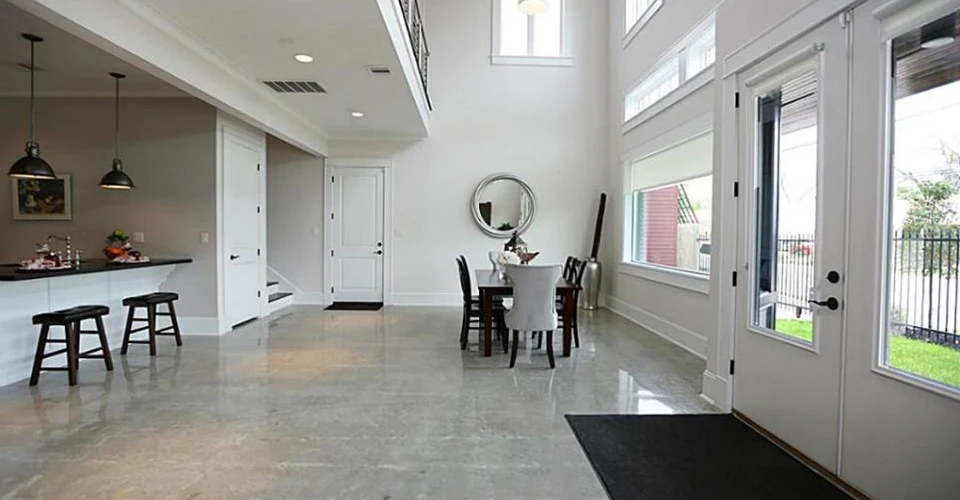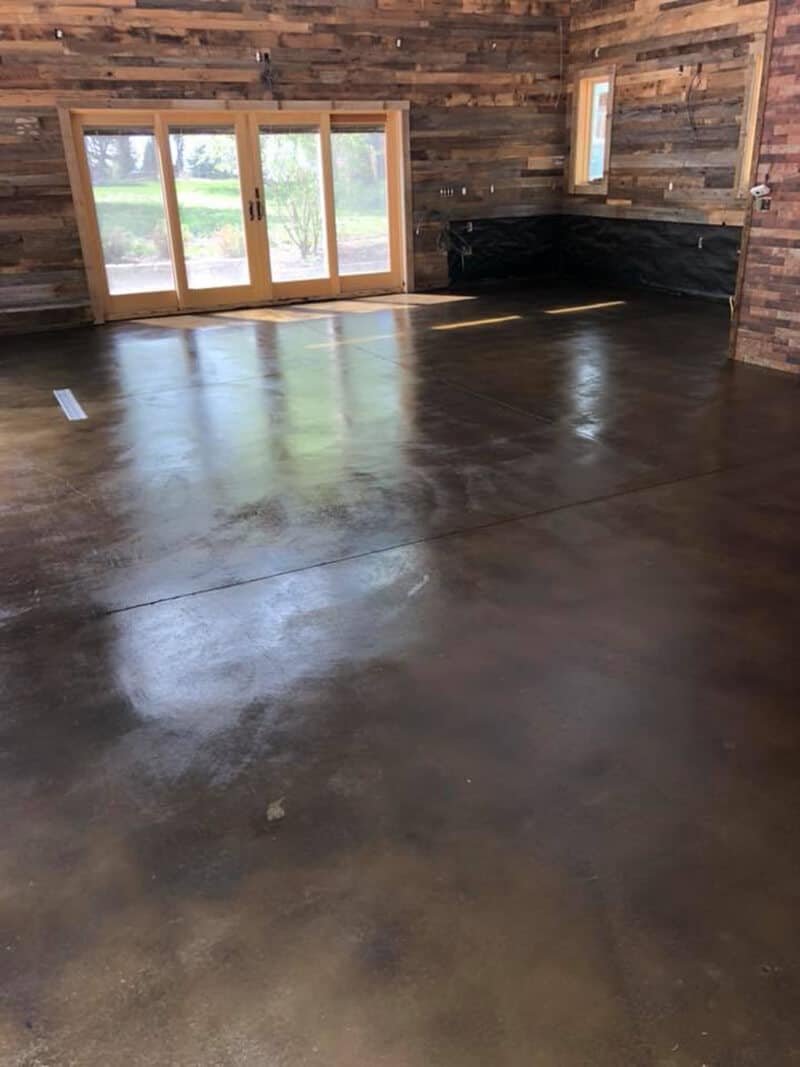Why Regional Tarnished Flooring Is the Perfect Option for Sustainable Home Renovation
In the realm of sustainable home renovation, local discolored flooring has actually emerged as a preferred selection amongst ecologically conscious home owners. As an economical investment with reduced upkeep requirements, it elevates a thought-provoking inquiry: could this be the suitable option for sustainable housing?
Recognizing the Idea of Regional Stained Flooring
While the concept might seem unique to some, regional stained flooring is an ingenious method to home improvement that integrates aesthetic appeals, sturdiness, and sustainability. The term describes the usage of locally sourced wood that is discolored to attain an unique visual appeal. The staining process not just improves the all-natural elegance of the timber grain but additionally adds a layer of protection, enhancing the long life of the flooring. This method is thought about lasting as it minimizes the demand for transportation of basic materials from far-off locations, hence lessening carbon impacts. Utilizing local timber types commonly sustains regional economic climates and promotes liable forest administration practices. This principle, as a result, provides home owners an environmentally accountable selection without jeopardizing aesthetic charm or toughness.
The Visual Appeal of Regional Tainted Flooring
Why is regional stained flooring acquiring appeal for its aesthetics? The answer hinges on the distinct beauty and character it offers any kind of space. Local discolored flooring provides a varied variety of patterns and shades, mirroring the natural charm and variations of the regional wood species used. This creates an one-of-a-kind, personalized aesthetic that can not be reproduced by mass-produced choices. Furthermore, the staining procedure enhances the timber's innate grain and appearance, including deepness and splendor to the floor's appearance. This rustic style flawlessly blends with numerous interior decoration styles, from standard to modern-day, making it a versatile option for home owners. Eventually, the attraction of regional discolored floor covering depends on its capability to transform homes right into distinctive, visually appealing areas while advertising sustainability.
Environmental Impacts of Neighborhood Discolored Floor Covering
The environmental ramifications of local tarnished flooring include two substantial factors: decreasing carbon footprint and waste minimization advantages. Using in your area sourced materials for tarnishing not just decreases transport exhausts, however additionally promotes sustainable forestry techniques. The waste reduction facet comes right into play as these floor covering types commonly have a longer life expectancy, minimizing the constant need for substitutes and the waste associated with it.
Lowering Carbon Impact
As property owners turn to even more sustainable options, regional stained flooring emerges as a viable service to minimize carbon impact. This kind of flooring mostly makes use of in your area sourced materials, which dramatically minimizes the need for transport. As a result, this reduces discharges connected with freight transport, contributing to reduced levels of greenhouse gases in the ambience. In addition, the process of tarnishing the flooring, rather than making use of synthetic finishings, includes fewer chemicals and less energy-intensive procedures. This causes a reduction in carbon discharges throughout the manufacturing procedure. Deciding for local stained flooring demonstrates an efficient procedure in advertising environmental sustainability, highlighting a substantial way homeowners can add to combating environment modification from the convenience of their own homes.
Waste Minimization Benefits
Although commonly ignored, waste minimization is another considerable advantage of regional tarnished floor covering. Furthermore, the staining procedure utilizes less resources and generates much less waste compared to manufacturing new floor covering products. The choice of regional discolored flooring not only improves homes yet also underpins a commitment to sustainable living and waste decrease.
The Durability and Maintenance of Regional Tainted Flooring

The Cost-Effectiveness of Neighborhood Tarnished Floor Covering
While regional discolored floor covering could originally seem a lot more pricey than other choices such as carpet or laminate, its longevity and sturdiness promptly turn it into an affordable option. For homeowners looking for a lasting, affordable option for their flooring needs, local discolored flooring emerges as a remarkable, lasting investment that pays off over time.

The Real World Instances of Lasting Homes With Neighborhood Tainted Flooring
In the world of sustainable home enhancement, neighborhood discolored floor covering has become a preferred alternative. To further highlight its advantages, numerous the real world examples of environmentally friendly homes that have actually efficiently integrated this floor covering method will certainly be highlighted. These study supply concrete proof of the advantages and influence of using neighborhood discolored floor covering in lasting homes.

Showcase: Eco-Friendly Flooring Houses
Scanning the world, one can locate numerous homes that personify the concept of eco-friendly living via the usage of regional tarnished floor covering. Across seas in copyright, a modern abode showcases its abundant, maple-stained floor covering, a testament to the plentiful regional wood supply (Best Stained Concrete Austin). These homes not only showcase the visual versatility of his comment is here neighborhood discolored flooring however likewise its contribution to a more sustainable lifestyle.
Local Stained Flooring Benefits
The obvious allure of regional tarnished floor covering extends beyond its aesthetic appeal, as it also supplies considerable benefits to both house owners and the environment. This sort of floor covering is sourced and created in your area, lessening transportation exhausts and bolstering the regional economy. The discoloration procedure utilizes natural, non-toxic products, promoting indoor air high quality and reducing the home's ecological impact. In a sustainable home in Portland, Oregon, for example, neighborhood discolored concrete floorings not just boost the aesthetic appeals yet also work as thermal mass, absorbing heat throughout the day and launching it at night, reducing energy usage. An additional example is a green-certified home in Austin, Texas, where locally sourced walnut was tarnished and used for flooring, contributing to the home's LEED top article qualification.
Conclusion
Finally, local tarnished floor covering is a practical and sustainable option for home improvement. This option supports neighborhood economies, reduces ecological influence, and boosts home aesthetics. Its resilience ensures longevity, minimizing maintenance expenses in the long run. With its distinct mix link of environmental, aesthetic and economical advantages, neighborhood tarnished floor covering is a clear selection for property owners looking for a sustainable, aesthetically attractive and economical home renovation service.
In the realm of sustainable home renovation, neighborhood stained flooring has arised as a preferred selection amongst environmentally mindful homeowners. Regional discolored floor covering offers a diverse variety of patterns and shades, showing the natural beauty and variants of the regional wood species made use of. The option of regional tarnished flooring not only beautifies homes yet also underpins a dedication to sustainable living and waste decrease.
For house owners seeking a lasting, economical option for their flooring requires, local stained flooring arises as a superior, long-term financial investment that pays off over time. Commercial Stained Concrete Floors.
With its unique blend of environmental, economical and visual advantages, neighborhood tarnished flooring is a clear choice for property owners seeking a lasting, aesthetically appealing and economical home renovation solution.